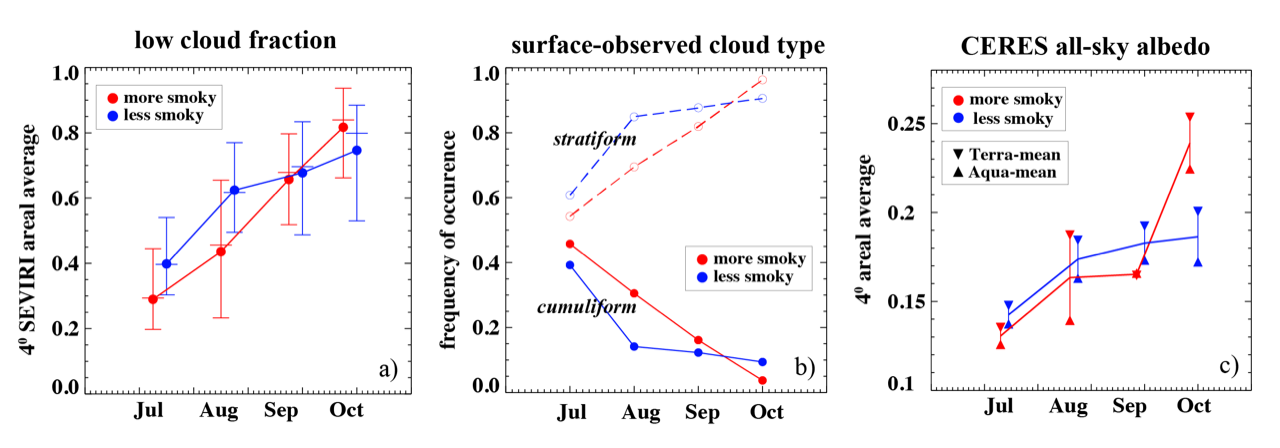Seasonal cycle in SE Atlantic low cloud fraction amplified in the presence of smoke
Submitter:
Zuidema, Paquita — University of Miami
Zhang, Jianhao — NOAA Chemical Sciences Laboratory
Area of research:
Cloud-Aerosol-Precipitation Interactions
Journal Reference:
Science
The subtropical Atlantic Ocean hosts one of the planet's largest marine low cloud decks and interacts with biomass burning aerosol from approximately June through October. This study details how the monthly evolution in meteorology and the aerosol vertical structure relates to the seasonal cycle in low-cloud fraction. The smoke is primarily in the boundary layer in July-August; then, as the African continent warms, the September-October large-scale circulation encourages more aerosol transport in the free troposphere. Low cloud cover increases climatologically from July to October and becomes more stratiform. We find that the combination of changing winds and aerosol transports helps reinforce the July–October evolution in low cloud cover and cloud morphology, compared to conditions with less aerosol present. Ascension Island is at the northwest edge of the southeast Atlantic stratocumulus deck, and one way to understand this is that in the presence of smoke, the stratocumulus deck contracts or expands, depending on the height at which the aerosol is present.
Impact
Low clouds, through modulating the reflected solar radiation, govern the top-of-atmosphere radiation budget. Despite similar seasonal cycles in sea surface temperature and large-scale circulation patterns, the monthly-mean southeast Atlantic low-cloud fraction increases more, compared to its counterpart of the southeast Pacific, during austral winter-spring. Differences in their respective aerosol environments may contribute to this. Representations of the low-cloud seasonal cycle in climate models serve as an indicator of model realism, by comparing with that derived from observations that can then be used as an emergent constraint on the spread in the model equilibrium climate sensitivity (ECS).
Summary
This study details the month-by-month changes in cloud properties and the large-scale environment (from ERA5) as a function of the biomass burning aerosol loading (both surface-based from the LASIC campaign and satellite-derived) at Ascension Island (8° S, 15° W) from July to October. During July-August, the low-cloud fraction is less and is increasingly cumuliform over Ascension when more smoke (usually in the boundary layer) is present. This is because the absorption of sunlight raises the boundary-layer temperature, reducing the relative humidity sustaining the clouds. The meteorology varies little as a function of smoke presence in July, indicating cloudiness changes can be more readily attributed to cloud-aerosol interactions in July compared to other months. Midlatitude disturbances intruding into the Atlantic subtropics in September constrain the free tropospheric aerosol and stratocumulus deck closer to the African coast while deepening, drying, and cooling much of the marine boundary layer. This indicates a synoptic contribution to the previously known finding that low cloud cover increases when more free troposphere smoke is present (by warming and stabilizing the lower free troposphere, reducing entrainment at cloud top). In October, low-level clouds similarly increase and are more stratiform over Ascension when more free-tropospheric smoke is present. Increases in above-cloud moisture likely also contribute then, through diminishing the cloud-top entrainment drying further.


